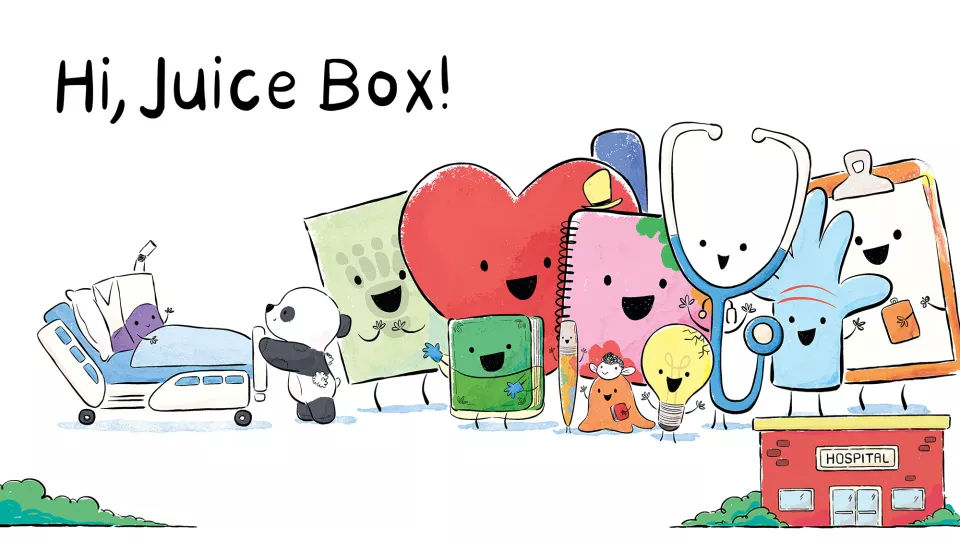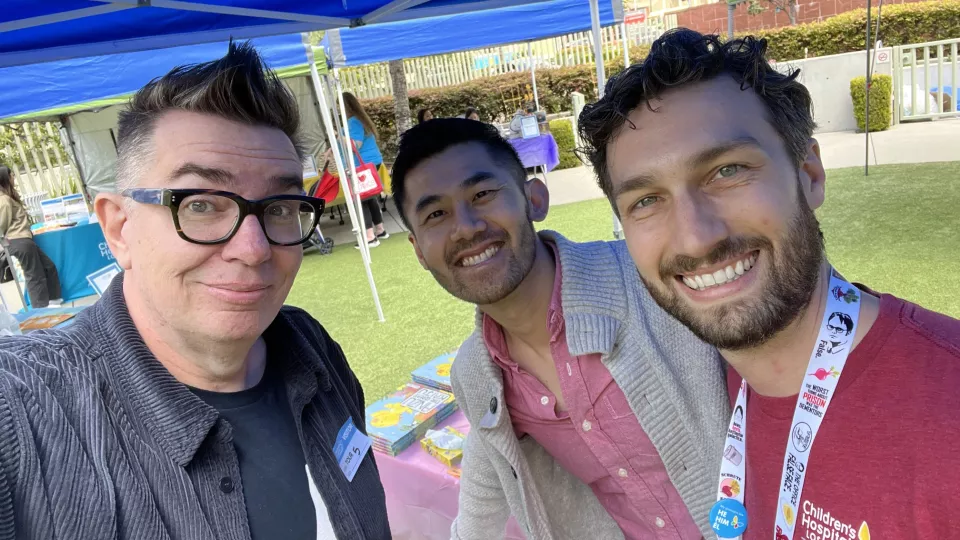
Author Drew Daywalt Writes New Picture Book for CHLA Library
Drew Daywalt gave Kyle Horne, MPH, CNP, his best elevator pitch:
“I told Kyle, every kid knows juice boxes,” says Daywalt, an acclaimed children’s book author. “We all lived on them. What if one got scrunched? He gets squeezed too hard and his straw gets tweaked and broken. He has to go into the hospital for long-term care because it's going to take a while to fix all his stuff.”
Daywalt’s proposition was in response to a request from Horne, Manager of Literally Healing, the literacy program at Children’s Hospital Los Angeles, which provides free daily books to hospitalized patients. Horne had found a hole in the program’s Therapeutic Library, a set of shelves in the CHLA Reading Room dedicated to books that explain to children the scarier aspects of being an inpatient. The library lacked a story about kids who have to stay in the hospital long-term.
“Most hospital books are like, you break an arm, you go to the hospital, you get an X-ray, you get surgery, you go home, and you're feeling better five days later,” Horne says. “And that's just not the reality for a lot of our kids. We wanted a book that showed that being in the hospital might be a bigger part of your life.”
Daywalt had already become a regular in the Reading Room. After appearing at CHLA’s Book Week in 2018, he enjoyed the experience so much that he became a weekly volunteer, straightening, sorting and stacking books, steering children to one they might like, and reading aloud to them.
“I was basically a librarian—and I loved every minute of it,” he says.
When Horne approached Daywalt with the one book on his wish list, he told him that it would enable Daywalt to reach many more hospitalized children than he could by volunteering. Daywalt signed on immediately, titling the book, “Hi, Juice Box! Juice Box stays at the hospital.”
Creating a friendly hospital environment
Daywalt’s participation was a big win. He has written multiple New York Times best-selling picture books, including his first release in 2013, “The Day the Crayons Quit,” which is ranked No. 25 on Time magazine’s 100 Best Children’s Books of All Time.
“It was a really big deal to get him,” Horne says.
Horne stayed mostly hands off. He only asked Daywalt to portray a hospital setting that would look less menacing to kids who have to reside in it for a lengthy period. The author chose to employ a favorite tool of his—creating a cast of objects that are representative of people, as he did with “The Day the Crayons Quit,” in which the crayons are talking characters.
In “Hi, Juice Box!” Juice Box encounters several benevolent medical devices, including an X-ray machine, an IV, a thermometer and a CT scanner. He also meets up with other objects that are hospitalized for conditions that parallel illnesses and injuries CHLA patients experience. A nightlight has a cracked bulb. A paintbrush takes medication that causes all its bristles to fall out, with the assurance that they will grow back once the treatment ends. A stuffed animal’s body is rejecting its natural stuffing, so it needs a stuffing transplant.
Daywalt did receive input from CHLA clinicians, who advised on which particular disorders they thought would most benefit patients to see represented in the book.
“There was a lot of back and forth,” Daywalt says, “making sure we had a book that could be used for a lot of different ailments and treatments.”
As Juice Box’s care team attempts to put him back together, he receives treatment and support that CHLA patients will recognize: A physical therapist works to “unsmoosh” his middle, and a Child Life specialist explains in easily understood words the various tests and procedures he has to undergo.
The book has a light and optimistic spirit, as Daywalt kept an eye on Horne’s goal of easing the fears of kids who have to endure long hospital stays. “For me,” he says, “it was like, ‘How can I entertain the children and at the same time get the information out that needs to get out?’”

An illustrator enters the picture
The narrative needed an illustrator to give it life, and both Daywalt and Horne thought of Benson Shum, an animator for Disney Animation who has also written several children’s books. It was Shum’s work as an author that led to his introduction to both men.
Shum met Horne in 2019, at CHLA’s annual Christmas in July Book Drive, where Shum was reading from his picture book “Holly’s Day at the Pool.” Horne invited Shum to participate in Book Week, where he then met Daywalt, who was also at the event. When Horne and Daywalt asked him to illustrate “Hi, Juice Box!” Shum eagerly agreed.
“When I read it, I fell in love with it,” Shum says. “That metaphor for something that's broken or something that needs healing I think is easy for kids to relate to and digest. An inanimate object makes it easier for us to put ourselves in that position.”
Daywalt took the same remote stance toward Shum’s work as Horne took toward his. “Nobody does their best when someone's got their hand on your hand while you're trying to draw,” he says. “Benson asked what were my thoughts, and I said, ‘My job was done when we hired you. I trust you. Go do your thing.’”
To ensure he was illustrating the environment accurately, Shum asked Horne to provide him with photos of the various hospital devices he’d be drawing.
“I wanted to make sure I was true to what the objects and instruments look like,” he says. “For example, there are so many different types of thermometers that I didn't even realize. I wanted to make sure they represented something that the kids are going to experience.”
A pro bono collaboration

Now completed, “Hi, Juice Box!” is expected to be on the shelves in CHLA’s Therapeutic Library soon. Daywalt and Shum both speak of feeling honored to be part of the project, and that was all the reward they wanted: Both insisted on working for free. Daywalt made it a condition of agreeing to the project.
“I wanted this to be 100% an act of love from everyone involved,” he says, noting that his lawyer, Jamie Coghill, provided his services without charge as well.
Shum saw an opportunity to work with an author he admired greatly, in the service of a story he knew could help many people. He mentions that his mother had serious health issues, which influenced him to participate in creating the book.
“It sounds cheesy, but sometimes we're so focused on the small things that we forget about everything else around us,“ he says. “If you're not in that situation, you kind of forget how important and wonderful it is to have help.”
Daywalt says the time he has spent at CHLA, capped by authoring the new book, has been only partly altruistic. When he tallies it up, he got back more than he gave. “This is my privilege,” he says. “I'm the big winner here.”
In Appreciation of Their Support
The translation and printing of “Hi, Juice Box! Juice Box stays at the hospital” was made possible by the generosity of the Whitney Young Children’s Foundation and the Peninsula Committee Children’s Hospital.
Literally Healing is also grateful to the Sharon D. Lund Foundation for the significant support it has provided the program for nearly two decades.
Available in English and Spanish
“Hi, Juice Box: Juice Box stays at the hospital” will be printed in English and Spanish and will be available on the CHLA website in multiple languages. In addition, other children’s hospitals will have access to the book.


